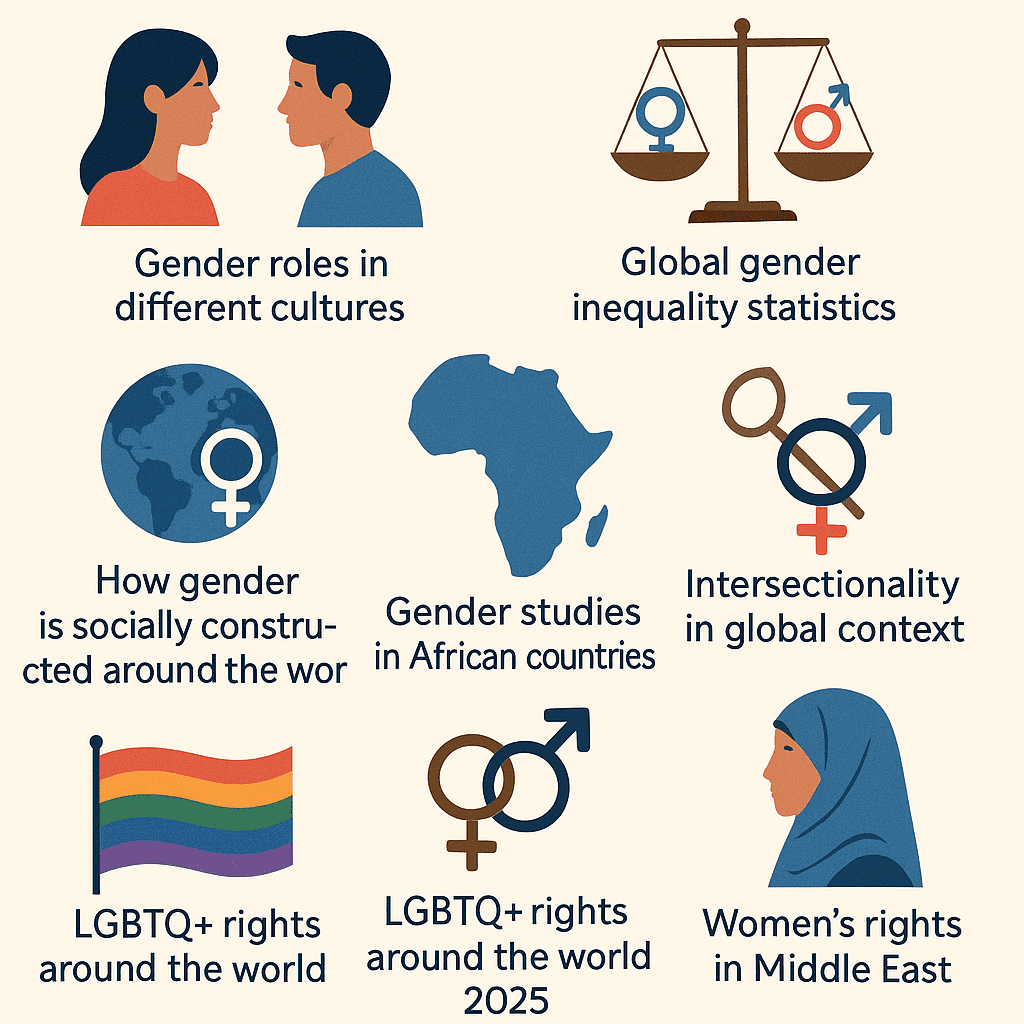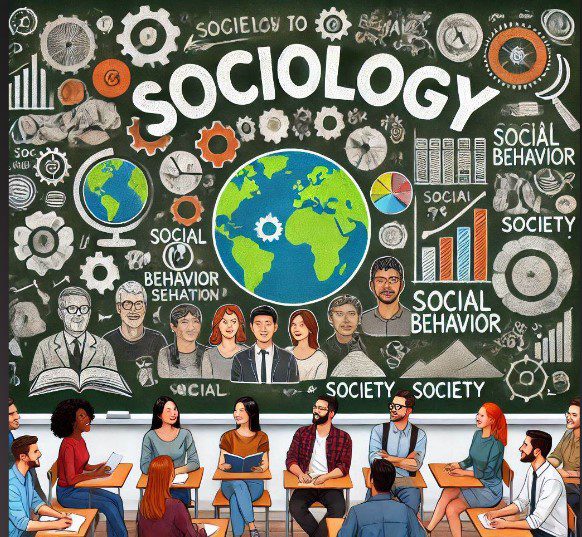Gender Roles in Different Cultures
Gender roles — the expectations, behaviours and responsibilities society assigns to people based on their gender — vary significantly across cultures, reflecting local history, religion, economy and power structures. In many societies, traditional gender roles define men as breadwinners and women as caregivers or homemakers. For example, in some rural agrarian settings, men may be responsible for heavy physical labour and external trade, while women manage the household and family welfare.
In other cultural contexts, these roles are more fluid or challenged by modernisation, migration or globalisation. Urban populations in many countries show shifting patterns: women increasingly participate in formal employment, higher education and leadership, while men may take on more domestic or caregiving tasks. Such shifts demonstrate that gender roles are socially constructed rather than biologically fixed. The cultural variation underscores the importance of understanding gender roles within each society’s norms, rather than assuming a universal template.
Global Gender Inequality Statistics
To ground the discussion in data: globally, gender inequality remains a persistent challenge. One widely used measure is the Gender Inequality Index (GII), which captures gender-based disadvantage in reproductive health, empowerment and the labour market.
Another measurement, the Global Gender Gap Index (GGGI), produced by the World Economic Forum, benchmarks gender parity across four key areas: economic participation and opportunity, educational attainment, health and survival, and political empowerment.
According to the 2024 snapshot, for example, no country has yet achieved full gender parity, and certain domains such as political empowerment are especially lagging (only about 22.5 % of the gap closed) in that year. UN Regional Information Center
More recently, the 2025 edition reports that globally 68.8 % of the gender gap has been closed across 148 economies.
Looking at country-level variation: in the “Gender Equality by Country 2025” listing, nations such as Iceland (0.935) lead, while others such as Pakistan score about 0.570 — showing a wide global spread.
These figures show that while progress is occurring, it is uneven and slow, and vast gaps remain across regions, sectors and groups.
How Gender Is Socially Constructed Around the World
The concept of gender as something socially constructed means that many of the differences we see between men and women are not purely biological, but shaped by culture, history, institutions and power. Social construction of gender implies that societies assign meanings to bodies, roles and behaviours, and these meanings can evolve.
For example, what counts as “masculine” or “feminine” varies over time and place: in one culture, being a productive agricultural worker may define masculinity; in another, being a corporate executive. Similarly, femininity may be constructed around caregiving, domestic labour, emotional work or professional achievement — or a mixture of roles.
These constructions are maintained through institutions (family, education, religion, media), symbols (clothing, rituals, language), and practices (division of labour, expectations of behaviour). Importantly, they also shape power relations: who has access to resources, who makes decisions, and whose work is valued or invisible (for instance, unpaid care labour is often undervalued).
Because gender roles are socially constructed, they can be changed — though change often requires shifts in culture, policy, and power. The field of gender studies examines these dynamics: how gender is defined, how it intersects with other identities (race, class, sexuality, age), and how power and inequality are reproduced or resisted.
Gender Studies in African Countries
On the African continent, the field of gender studies has developed significantly over the past decades. Scholars have emphasised the importance of local context, indigenous knowledge and the decolonisation of gender theory (that is, avoiding simply applying Western models to African realities).
For instance, gender research in Africa recognises that the idea of a gender binary or fixed gender roles may not map neatly onto all traditional African societies; there is diversity in how gender and generational roles are constructed.
Moreover, gender inequality remains a major development challenge in Africa. One review notes that despite policy and legal advances, many structural norms — around labour, family, land rights, conflict, and climate vulnerability — continue to hinder gender equality.
Institutions and networks such as the Association of Gender Studies in Africa (AGSA) support research, training and activism on gender issues across the continent.
In short, gender studies in Africa must attend to the interplay of culture, tradition, colonial legacies, economic change and globalisation — and how these shape both gender roles and opportunities for transformation.
Gender and Development Studies
Gender and development (G&D) studies is a subfield that links gender analysis with development theory, practice and policy. It examines how development processes (economic growth, poverty reduction, health and education programmes, infrastructure, governance) affect genders differently, and how gender inequalities affect development outcomes.
For example: when women lack access to education or employment, economic growth may be impeded; when men and women’s labour is segregated or when women’s unpaid care work is not considered, the benefits of development may be reduced. Conversely, when gender equality is advanced — through policies supporting women’s participation, leadership, investment in girls’ education, protection from violence — development outcomes improve.
Development agencies increasingly adopt “gender-transformative” approaches (rather than just “gender-sensitive”) to challenge root causes of inequality, such as social norms, power relations and institutional barriers. A case study in Africa (South Africa and Ghana) highlights how gender-transformative programming can improve health, nutrition and HIV outcomes.
In short, gender and development studies provide the analytical lens and policy framework to integrate gender equality as an essential component of sustainable development, rather than an add-on.
Intersectionality in Global Context
Intersectionality is a concept from feminist theory (especially from Black feminist thought) that emphasises how different social categories — gender, race, class, sexuality, disability, nationality, age — intersect to produce unique patterns of advantage and disadvantage. In global gender studies, intersectionality is crucial because gender inequality does not affect all women (or men) equally — the experience varies by location, identity, status and power.
For example, a woman in a rural low-income setting may face gender-based barriers differently from an urban professional woman; a lesbian or trans person may face both gender discrimination and homophobia/transphobia; migrant women may face racial and gendered discrimination; indigenous women may face gender, colonial legacies, land rights and cultural discrimination.
By applying intersectionality, scholars and practitioners recognise that policies aimed at “women” as a homogeneous group may miss the differential impacts of class, ethnicity, sexuality, age and ability — and so may perpetuate inequalities. Gender studies around the world increasingly adopt intersectional lenses to ensure a more nuanced understanding and more effective interventions.
LGBTQ+ Rights Around the World in 2025
The rights of lesbian, gay, bisexual, trans and queer (LGBTQ+) people form a key dimension of global gender justice, as gender identity and sexual orientation intersect with social norms, law and power. The situation in 2025 is mixed: there is both progress and significant backlash.
According to data from ILGA World and other sources:
-
As of mid-2025, 64 UN member states still criminalise consensual same-sex sexual acts.
-
The legal equality index for LGBTQ+ rights (which considers aspects such as same-sex marriage, discrimination protections, gender recognition) shows wide global variation.
-
Some countries are advancing: for instance, the decriminalisation of gay sex in Namibia and Dominica, self-identification laws in Germany and Ecuador.
-
At the same time, there are severe setbacks in other places: increasing anti-LBGTQ laws and repression.
In short, while rights for LGBTQ+ people have expanded globally in some places, the global picture remains deeply uneven and contested. The commitment to gender and sexual minority rights is increasingly becoming a frontline issue in global gender studies and human rights policy.
Women’s Rights in the Middle East
Women’s rights in the Middle East (and North Africa) region are shaped by a complex interplay of tradition, religion, state policy, global norms and activism. While there has been progress in areas such as education and health, many structural challenges persist.
Key points:
-
Many MENA states maintain legal frameworks that discriminate against women in family law (for example, guardianship, divorce, child custody), nationality rights and protection from gender-based violence.
-
Cultural expectations often expect women to prioritise family and domestic roles over careers; women’s agency (in choices about marriage, employment, mobility) can be constrained by institutional norms.
-
Surveys in the region show that while many believe women should have equal access to things like university education (75 %), employment (84 %) and politics (62 %), there is still a strong divide between ideas of equal rights and the social roles women are expected to inhabit.
-
Nevertheless, some countries in the region are attempting reforms — for example in the Gulf states where women’s labour participation, leadership roles or legal status are evolving — but the pace remains slow and the horizon for full gender parity in the region is projected to be many decades away.
Thus, while women’s rights in the Middle East are advancing in some respects, systemic barriers remain large and embedded, calling for continued reform and activism.
Conclusion
In summary, gender studies around the world reveal a complex and evolving picture: gender roles differ widely across cultures and are socially constructed; global gender inequality remains deeply entrenched though some gaps are closing; the field of gender and development emphasises the centrality of gender in sustainable development; gender studies in Africa highlight the need for context-sensitive approaches; intersectionality reminds us that gender intersects with other identities and forms of disadvantage; LGBTQ+ rights in 2025 show both progress and significant resistance; and women’s rights in the Middle East illustrate how tradition, religion, law and modernisation intersect in shaping gender dynamics.
While there are reasons for cautious optimism — changing norms, legal reforms, increased scholarship and activism — the global data suggest that much more remains to be done. The road to gender equality is long, and progress will require sustained attention to culture, power, politics and intersectional identity.


